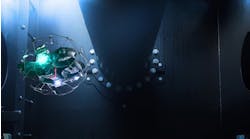Construction of the replacement for the South Module on Texaco's Petronius compliant tower in Vioska Knoll block 786 of the US Gulf of Mexico is about 40% complete, Fred Palmer, Texaco spokesman said. The original module, which includes water injection equipment and crew quarters, was lost last year during installation.
The replacement is under construction at the Gulf Island Fabrication Yard in Houma, Louisiana, the same yard that constructed the original. Work began on February 2 of this year and progress is on track. The module will be completed in the first quarter of 2000.
Installation of the module will begin in March-May, 2000. On the current schedule, production from the field should begin in January of 2001. The original first oil was scheduled for mid-1999. Palmer said the North Module and other topside facilities have been maintained, while awaiting the replacement module, and are ready to go into service. Once the module is set and hooked-up, it will go through a commissioning process and be ready to produce first oil.
ABB to build first 15,000 psi horizontal tree
Amerada Hess has awarded ABB Vetco Gray a contract to build what it claims is the world's first 15,000 psi horizontal tree for a high pressure field in the US Gulf of Mexico. The 4-in. by 2-in 15 KSI diverless subsea production tree, rated to 250° will be installed on the Conger Field, Garden Banks block 215 N/2 in 1,450 ft of water.
The contract also calls for the first use of a horizontal tree installation package developed by ABB and part of its Well Intervention and Test System (WITS). The trees are scheduled for delivery in September 2000. Amerada Hess also has an option for two additional trees. The Congar gas field will be developed using flowlines linked to a nearby platform, Shell Salsa. The field will come on stream in the fourth quarter of 2000.
ABS moves synthetic mooring forward
ABS recently released a comprehensive set of Guidance Notes for the use of synthetic ropes in offshore mooring applications. This is seen as a reflection of the growing popularity of such systems in deepwater applications. In deeper waters, synthetic mooring systems offer a number of efficiencies over conventional mooring or dynamic positioning in certain field development scenarios.
The availability of the synthetic materials and alternate mooring systems has extended the economic capability of existing floating technology into deeper water, ABS Vice president of Offshore Technology Malcolm Sharples said. The lightweight of these synthetic systems frees up more deck capacity on floating production facilities, which can then accommodate more recovery and processing equipment. These advantages become especially pronounced in water depths beyond 3,000 ft.
Synthetics are made of polyester or other man-made fibers and are much lighter than either chain or wire rope. In addition to reducing the deck load, synthetics offer improved extreme dynamic tensions. ABS was involved with Petrobras on a recent deepwater project that contributed to the development of the Guidance Notes (ABS - www.eagle.org). The project was on the Campos Basin P-27 semisubmersible floating production unit. Installed in April of last year, ABS classed the P-27 for 1,700 ft water depth near the Marlim Field offshore Brazil.
The installation included 12 anchoring lines with polyester ropes and the industry's first production installation of vertically loaded anchors. Four taut-leg anchors were set 80 ft apart in the seafloor within a close radius of the installation giving the mooring system a much smaller footprint than a conventional cantilever installation using drag anchors and wire rope and chain. A cantilever system in 3,000 ft water depth would require a spread of 7,500 ft where the same installation of a taut-leg system in the same water depth covers only 3,000 ft.
In addition to this scenario, there also is the option of a hybrid system that includes synthetic ropes in a catenary design. This combination of synthetics and chain-wire components offer greater design flexibility for facilities and associated field development schemes.
Regardless of the design, the key is to protect the synthetics from abrasion and wear. Wire chain is necessary at the top and bottom of the mooring system, while polyester is used through the water column. This design approach protects the synthetic fibers from sand along the seafloor and ensures appropriate handling of the rope at the fairlead, the pivot point for directing the mooring line near the vessel water line. Synthetic rope is very strong, but careful planning is required to ensure safe use of the polyester fibers for an estimated field life of 20 years.
Mobile rig moors in 6,134 ft water depth
Transocean Marianas, which began working for Shell last August, set a record drilling the Voltron test well in Green Canyon 854. The record was for drilling from a moored mobile offshore rig in 5,381 ft of water. The previous record was 5,297 ft, set by the Transocean Richardson in the Gulf of Mexico in 1996.
On its next project for Shell, the Ariel discovery in Mississippi Canyon 429, the Marianas broke its own record spudding an appraisal well in 6,134 ft of water. The rig was moored using Shell's suction pile technology, which consists of suction anchors, steel mooring lines and syntactic foam buoys. This mooring system can extend the rig's abilities to at least 7,000 feet of water.
Cone penetrometer record set in Black Sea
Gazprom has reported that two new in-situ geotechnical testing records were set during the recently completed detailed pipeline route survey for the planned Blue Stream pipeline. This Gazprom project will install twin 24-in. gas pipelines at the record depth of 2,150 m across the Black Sea from Russia to Turkey. Gazprom Director Euri Goryainov said one important aspect of the survey was the evaluation of mass gravity flows, slope stability, and soils characteristics. The work was managed by PeterGaz with technical support from INTEC Engineering.
Fugro BV of Holland conducted the survey in seabed mode from the geotechnical survey vessel IM.V. Bavenit, owned by AMIGE of Russia. Considerable technological development and innovation was required to take in-situ tests (cone penetrometer (CPT), and shear vane) in more than 2,000 m of water. Simon Bonnell, Technical Specialist with INTEC said it was necessary to develop a CPT that had very low bearing on the seabed so it could be supported by the weak soil. To accomplish the demanding scope of work Fugro used a combination of systems. The Seascout system was modified to perform 5 m pushes using a straight rod and a 33-cm cone. The unit also allowed Fugro to install an in-situ shear vane module on the bottom of the Seascout to conduct tests to a depth of 5 m below the seabed. The records were set using the 40 m CPT unit called the Wheeldrive Seacalf which was deployed through the moon poll of the Bavenit. This CPT was developed to push a 40 m straight rod that was made up in sections. It recorded data both at the seafloor and at the top side to provide a failsafe back-up. The Wheeldrive unit set water depth records when used in the assessment of the stability of the Turkish Slope. The first record was set when it performed a 40 m CPT in 1,840 m. The second record was a 20 m stroke shear vane in 1,600 m of water.


